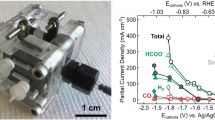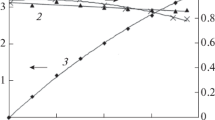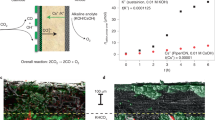Abstract
An electrochemical ozone generation process was studied wherein glassy carbon anodes and air depolarized cathodes were used to produce ozone at concentrations much higher than those obtainable by conventional oxygen-fed corona discharge generators. A mathematical model of the build up of ozone concentration with time is presented and compared to experimental data. Products based on this technology show promise of decreased initial costs compared with corona discharge ozone generation; however, energy consumption per kg ozone is greater. Recent developments in the literature are reviewed.
Similar content being viewed by others
Abbreviations
- A :
-
electrode area (m2)
- Ar * :
-
modified Archimedes number, d b 3 gαG/ν2 (1 — αG)
- C O 3 (aq) :
-
concentration of dissolved ozone (mol m−3)
- C O 3 i :
-
concentration at interface (mol m−3)
- C O 3 1 :
-
concentration in bulk liquid (mol m−3)
- D :
-
diffusion coefficient (m2 s−1)
- E :
-
electrode potential against reference (V)
- F :
-
charge of one mole of electrons (96 485 C mol−1)
- g :
-
gravitational acceleration (9.806 65 m s−2)
- i :
-
current density (A m−2)
- i 1 :
-
limiting current density (A m−2)
- I :
-
current (A)
- j :
-
material flux per unit area (mol m−2 s−1)
- k obs :
-
observed rate constant (mol−1 s−1)
- k t :
-
thermal conductivity (J s−1 K−1)
- L :
-
reactor/anode height (m)
- N O 3 :
-
average rate of mass transfer (mol m−2 s−1)
- Q :
-
heat flux (J s−1)
- r i :
-
radius of anode interior (m)
- r a :
-
radius of anode exterior (m)
- r c :
-
radius of cathode (m)
- R :
-
gas constant (8.314 J K−1 mol−1)
- S c :
-
Schmidt number, v/D
- Sh :
-
Sherwood number, k m d b/D = i L d b/zFD[O3]
- t :
-
time (s)
- T i :
-
temperature of inner surface (K)
- T o :
-
temperature of outer surface (K)
- U :
-
reactor terminal voltage (V)
- ν:
-
electrolyte linear velocity (m s−1)
- V :
-
volume (m3)
- V O 3 :
-
volume of ozone evolved (10−6 m3 h−1)
- z i :
-
number of Faradays per mole of reactant in the electrochemical reaction
- αG :
-
gas phase fraction in the electrolyte
- δ:
-
(mean) Nernst diffusion layer thickness (m)
- Φ:
-
fractional current efficiency
- η:
-
overpotential (V)
- ν:
-
electrolyte kinematic viscosity (m2 s−1)
- ρ:
-
electrolyte resistivity (V A−1 m)
References
S. Stucki and G. Theis, ‘In situ Production of Ozone in Water Using a SPE Electrolyse.’ Paper 673, 163rd Meeting of the Electrochemical Society, 8–13 May (1983), San Francisco, CA.
S. Stucki, G. Theis, R. Kotz, H. Davantay and J. J. Christen, J. Electrochem. Soc. 132(2) (1985) 367–71.
H. P. Klein and S. Stucki, ‘The Production of Ozone by Electrolysis and its Application to High Purity Water Systems’. 7th Ozone World Congress, International Ozone Association, Tokyo, 9–12 September (1985).
Chlorine Engineers Corporation Ltd., Shosen Mitsui Bldg., 1-1, Toranomon 2-chome, Minato-ku, Tokyo 105, Japan (Brochure, 1991).
Permelec Electrode Ltd., 1159 Ishikawa, Fujisawa City, Kanagawa Prefecture, Japan (Brochure, 1991).
M. Katoh, Y. Nishiki, and S. Nakamatsu, ‘A Study on Electrochemical Ozone Generator Using Oxygen Gas Diffusion Cathode’. Meeting of the Japan Electrochem. Society, April 1992.
E-TEK, Inc., 6 Mercer Road, Natick Industrial Park, Natick, MA 01760, USA.
P. C. Foller and C. W. Tobias, J. Electrochem. Soc. 129 (1982) 505.
P. C. Foller and M. L. Goodwin, Ozone: Sci. & Engng 6 (1984) 29–36.
P. C. Foller and C. W. Tobias, ‘Ozone Production by Electrolysis’, US Patent 4 316 782 (1982).
P. C. Foller, M. L. Goodwin and C. W. Tobias, ‘Electrodes for Ozone Production’, US Patent 4 375 395 (1983).
P. C. Foller, ‘Process and Device for the Generation of Ozone via the Anodic Oxidation of Water’, US Patent 4 541 989 (1985).
C. A. Wamser, J. Am. Chem. Soc. 70 (1948) 1209–15.
C. A. Wamser, J. Am. Chem. Soc. 73 (1951) 409–16.
A. J. Bard, R. Parsons and J. Jordon (eds.), ‘Standard Potentials in Aqueous Solution’, Marcel Dekker, New York (1985).
J. D. Seader and C. W. Tobias, Ind. Eng. Chem. 44(9) (1952) 2207.
T. R. Beck and R. W. Moulton, J. Electrochem. Soc. 103(4) (1956) 247.
D. P. Semchenko, E. T. Lyubushkina and V. Lyubushkin, Electrokhimiya 9(11) (1973) 1744.
P. C. Foller and C. W. Tobias, J. Electrochem. Soc. 129 (1982) 568.
H. P. Fritz, J. C. G. Thanos and D. W. Wabner, Z. Naturforsch. 34B (1979) 1617.
J. C. G. Thanos, H. P. Fritz and D. W. Wabner, J. Appl. Electrochem. 14 (1984) 389.
D. W. Wabner and J. C. G. Thanos, J. Electroanal. Chem. 182 (1985) 37.
J. C. Hwang, ‘Electrolytic Generation of Ozone’. Paper 592, 166th Meeting of the Electrochemical Society, New Orleans, 7–12 October (1984).
A. M. Couper and S. Bullen, in ‘Electrochemical Engineering and the Environment’, I. Chem. E. Symp. Series No. 127, I. Chem. E., Rugby (1992) pp. 49–58.
N. Watanabe, T. Nakajima and H. Touhara, ‘Graphite Fluorides’, Elsevier, Amsterdam (1988) pp. 1–22.
F. Solomon, US Patent, 4 927 515 (1990).
I. Rousar, K. Micka and A. Kimla, Electrochemical Engineering, Vol. 2, Elsevier, Amsterdam (1986).
I. Rousar and V. Cezner, Electrochim. Acta 20 (1975) 289, 295.
L. J. J. Janssen, G. J. Visser, J. Appl. Electrochem. 21 (1991) 753.
J. M. Bisang, ibid. 21 (1991) 753.
J. M. Bisang and G. Kreysa, ibid. 18 (1988) 422.
R. E. Meredith and C. W. Tobias, Adv. Electrochem. electrochem. Engng. 2 (1965) 15.
R. E. Meredith and C. W. Tobias, J. Appl. Phys. 31 (1960) 1270.
H. Vogt, J. Appl. Electrochem. 17 (1987) 419.
L. J. J. Janssen and G. J. Visser, ibid. 21 (1991) 386.
L. Sigrist, O. Dossenbach and N. Ibl, ibid. 10 (1980) 223.
H. Vogt, in ‘Comprehensive Treatise on Electrochemistry’, Vol. 6, (edited by E. Yeager, J. O' M. Bockris, B. E. Conway and S. Sarangapani), Plenum, New York (1983).
H. Vogt, Electrochim. Acta 34 (1989) 1429.
R. Battino (ed.), Solubility Data Series, Vol. 7, Pergamon/IUPAC, Oxford (1981).
D. D. Wagman, W. H. Evans, V. B. Parker, R. H. Schumm, I. Halow, S. M. Bailey, K. L. Churney and R. L. Nuttall, J. Phys. Chem. Ref. Data 11 (Supplement 2) (1982).
L. Sigrist, O. Dossenbach and N. Ibl, Int. J. Heat Mass Transfer 22 (1979) 1397.
G. Kreysa and M. Kuhn, J. Appl. Electrochem. 15 (1985) 517.
T. Sakai, H. Takenaka, E. Torikai, J. Electrochem. Soc. 133 (1986) 88.
J. Hoigne, ‘Mechanisms, Rates, and Selectivities of Oxidation of Organic Compounds Initiated by Ozonation of Water’, in ‘Handbook of Ozone Tech nology and Applications’, (edited by R. G. Rice and A. Netzer) Ann Arbor Science, Ann Arbor, MI (1982) p. 341 ff.
C.-H. Kuo and F. H. Yocum, ‘Mass Transport of Ozone in Aqueous Systems’, ibid.‘ pp. 105 ff.
Author information
Authors and Affiliations
Rights and permissions
About this article
Cite this article
Foller, P.C., Kelsall, G.H. Ozone generation via the electrolysis of fluoboric acid using glassy carbon anodes and air depolarized cathodes. J Appl Electrochem 23, 996–1010 (1993). https://doi.org/10.1007/BF00266121
Received:
Revised:
Issue Date:
DOI: https://doi.org/10.1007/BF00266121




